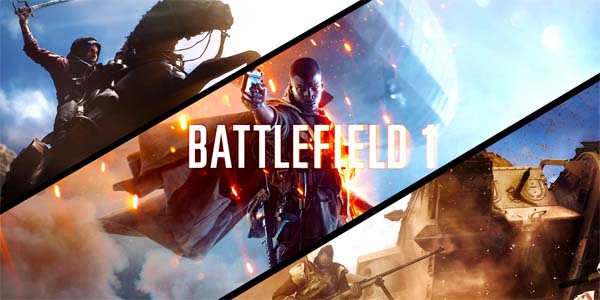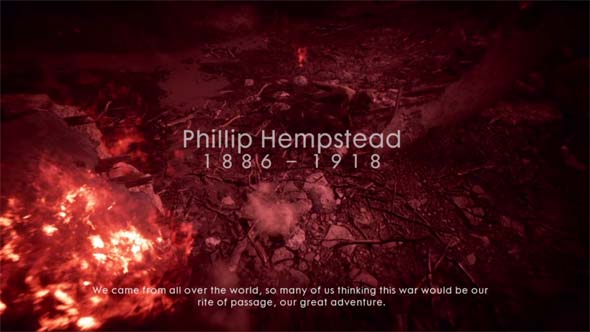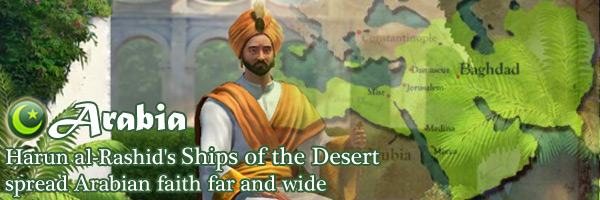
Nobody can make a game about World War I. Trench warfare is too boring. Nothing really happens. There isn't a strong, identifiable villain or good versus evil struggle.
Those are among the many excuses that people made for why all the video games are about World War II, and never about World War I. And then the gaming public and journalists got a glimpse of this:
The teaser trailer for Battlefield 1 was a smash hit.
That teaser trailer was damn good. People were excited. I haven't played a first-person shooter since Call of Duty: World at War, I generally hate online shooters, but even I was excited to try out this game! And other people were hyped about it too.
Now, I never really bought into the idea that World War I was "not video game material". I've long advocated for games to look at all periods of history for inspiration, and World War I is a monumental moment in world history that certainly deserves to be examined by games. The indie market certainly realized this, with games like Valiant Hearts and Verdun. But the big publishers have completely shied away from "The War to End All Wars".
This is a shame. The rapid technological advancements and radically new military tactics that evolved leading up to (and during) the war could be great material to examine in the form of a game. The widescale industrialization of warfare, the complicated politics, and the general fuzziness of the morality of the war are also ripe source material for dramatic storytelling. So it's about time to see this war thrust into the mass market spotlight.
I'd prefer to have seen a strategy game along the lines of Total War; but whatever, I'll give DICE and Battlefield 1 a chance.
UPDATE: 12 MARCH 2018, Better than I gave it credit for:
After having played Activision's Call of Duty: WWII and (especially) EA's Star Wars:
Battlefront II, and having talked about it with friends, I have gained a bit of respect for the successes that Battlefield 1 has been able to accomplish. I've started to like it more in retrospect. Not enough to go back and re-play it or try out any of the expansions (yet), but I do feel that I may have been a bit too harsh on the game in retrospect, especially with regard to its campaign vignettes.
I'm not going to change my original review score, but compared to CoD:WWII and Battlefront II, this game probably deserves a slightly higher grade. So keep that in mind as you read the following review. Of all the big-budget first person shooters that I've played in the past couple years, Battlefield 1
is probably the one that I most enjoyed, and it's the one that I would recommend.
The futile indifference of war
First impressions were actually pretty damned good. I was actually really impressed with Battlefield 1's campaign tutorial. It's basically a guided tour of the game's various core mechanics: shooting at enemy soldiers, capturing victory points, piloting vehicles, and so forth. It does a good job of introducing each of these mechanics and systems by jumping the player around between multiple characters in a large-scale battle.
But what really stuck out to me was how the tutorial transitioned between these different set pieces, and how it handled player death. This tutorial is actually surprisingly merciless and difficult. As you complete one set piece, the game gradually (and subtly) increases the threat until it becomes overwhelming and your character dies (or they just kill you after a timer expires), which allows the game to teleport you to the point of view of another character for the next set piece. The dying character's name and birth / death years are shown on screen during the transition, granting that character with a certain degree of humanization.

The excellent tutorial emphasizes the indifference and futility of "The War to End All Wars".
Depending on how good you are at the game, you'll go through between half a dozen to a dozen different characters, each with a name and an age. And they all die. The tutorial makes this war look brutal and futile. It even has an almost Dark Souls-like indifference to the player character, killing you without a second thought and forcing you to respawn as another poor, dumb bastard who's about to die for his country, rather than restarting you at a checkpoint until you get it right.
I even wish DICE had gone a bit further by also displaying the character's birth place and maybe even a snippet or two of other biographical trivia. Maybe listing some hobbies, or saying that he was on his high school's varsity football team, or some other little detail like that. DICE settled for just the name and birth / death year, but it's still effective and establishes a very strong running theme throughout the tutorial. The point is a bit undercut by the rapid pacing and by how conventional the actual running and shooting feels. But I still walked out of this tutorial excited by what the rest of the campaign had to offer. [More]
1b3222c5-df25-48fc-8292-199702831456|1|5.0
Tags:Battlefield 1, Battlefield, EA, Electronic Arts, DICE, PC, mouse & keyboard, EA Origin, shooter, online, multiplayer, World War I, war, history, trench warfare, chemical weapon, Harlem Hellfighters, tank, biplane, horse, England, France, Germany, Ottoman Empire, Europe, Argonne Forest, Arabia, Laurence of Arabia, eBay

Continuing my series of strategy posts about Brave New World's modified civilizations, I'm going to take a look at strategies for Arabia. Arabia received a modest revision in Brave New World out of the box, having its national trait moderately redesigned. The old city connection economic focus has been regeared towards Brave New World's new trade route mechanic, and a religious buff was also added to make this civ more compelling for Gods & Kings mechanics.
The majority of the Arabian peninsula is harsh desert, and so massive human settlement did not begin until the rise of the Islamic empires of the middle ages. In the early seventh century, the Prophet Muhammad began preaching the tenets of Islam in Mecca and Medina, which united several Arabian tribes and led to the establishment of the Caliphate, an Islamic empire that began to extend its influence across the peninsula and beyond. In the mid seventh century, the Caliphate began conquering territory from the Byzantine empire and they completely destroyed the once-powerful Persian empire that had dominated the region since antiquity. At its height, the Caliphate extended from Portugal, Spain, and Morocco in the west, all the way to the borders of India in the east. Arabia's position as a crossroads between west and east made it a center for powerful trading hubs, and Arabian engineers and scientists developed advanced new mathematical concepts. Goods, knowledge, and religious beliefs from both ends of the known world (and beyond) often passed through Arabian trading bazaars, and much of the knowledge of the classical Greeks and Romans were preserved by Islamic scholars, eventually contributing to the European Renaissance centuries later.

Harun al-Rashid ruled during the mid eighth century during the Caliphate's golden age. He has been strongly romanticized by Arabian authors and scholars, and has even been mythologized in tales included in the Book of One Thousand and One Nights. He was known as a sharp political, intellectual, and military mind, but it is difficult to separate factual accounts from fictitious ones. Even his exact birth date is debatable. He was Caliph during one of the greatest periods of expansion of the early caliphates, but he also almost destroyed the Caliphate by dividing the empire among his sons instead of naming a single heir. This led to prolonged civil war between the sons, but the Caliphate did survive the turmoil.
[More]
91119a55-7a39-4ebe-9d91-07545ab26c34|3|5.0
Tags:Sid Meier's Civilization, Civilization V: Brave New World, Civilization V, ranged mounted unit, bazaar, Arabia, Harun al-Rashid, Ships of the Desert, Camel Archer, luxury resource, trade, trade route, caravan, cargo ship, religion, religious pressure, Religious Texts, Grand Temple, Market, Knight, Indonesia, oil, oasis, Civ-V
UPDATE (September 9, 2014, 2:45 PM Pacific Time)
Shortly after publishing this blog, I came across a forum post that contradicts the information presented in this blog post. As such, I will review the actual source code in the Civilization V dll, do some more testing with the game, and revise the post as necessary. In the meantime, I'll leave the unaltered post here, for posterity. I apologize for the inconvenience.
A lot of buildings in Civilization V mention that they are affected by tiles or resources "near the city", but this quality of being "near a city" is poorly-defined within the game. So what exactly does it mean? I haven't seen any in-depth articles about this topic on the web or in the game's Civilopedia, so I thought I'd outline the important bits here.
Basically, a tile is "near" a city if that city was the first city in its respective empire to claim that tile within its workable radius.
So if you have a single tile or resource that lies between two cities, and both cities' workable ranges overlap that same tile, then that tile is not "near" both cities. It is only "near" the first city that owned that tile. This means that if you go into the city management screen and assign the second city to work that tile, it may receive yield bonuses associated with any improvements or buildings that affect it (such as the stable buffing pasture resources), but the tile's contents will not be considered "near" that second city for other purposes. This includes:
- requirement of an improved Horse or Ivory to build a Circus,
- requirement of an improved Horse, Cow, or Sheep to build a Stable,
- requirement of an improved Iron to build a Forge,
- requirement of an improved Stone or Marble to build a Stone Works,
- requirement of an improved Gold or Silver to build a Mint,
- wonder production bonus from nearby Marble,
- requirement that the city be adjacent to a Mountain in order to build an Observatory,
- trade route income from resource diversity,
- and so on...
Say you have two cities (for example Rome and Antium) whose workable ranges overlap a pastured Horse. Rome was the first city to claim the Horse tile. Rome can, therefore, build a Circus (assuming Trapping has been researched). If you go to the management screen of Antium, you can assign it to work the Horse tile (which prevents Rome from being able to work that tile), but Antium still cannot build a Circus. That is, two cities cannot build a building that requires they both have the same tile.
[LEFT] Rome has annexed a tile containing horses and is building a Circus.
[RIGHT] Later, that tile overlaps with Antium's workable radius, but it cannot build a Circus because the horse was originally claimed by Rome.
Alternatively, if a resource is claimed by a city's culture, but is outside of a city's workable radius (four tiles or more away), then it never counts as "near" that city... [More]
c178571d-236f-4930-b087-5ba4b365ee97|0|.0
Tags:Sid Meier's Civilization, Civilization V, Civilization, Civilization V: Gods & Kings, Civilization V: Brave New World, Civilization: Beyond Earth, building, near, resource, luxury, resource diversity, Arabia, bazaar, Poland, Portugal, mare clausum, trade route, circus, stable, forge, stone works, mint, city borders, owned tiles, Ducal Stable, Civilization V
|

| 12 | | | | | | | 60 | | 11 | | | | | | | 55 | | 10 | | | | | | | 50 | | 09 | | | | | | | 45 | | 08 | | | | | | | 40 | | 07 | | | | | | | 35 | | 06 | | | | | | | 30 | | 05 | | | | | | | 25 | | 04 | | | | | | | 20 | | 03 | | | | | | | 15 | | 02 | | | | | | | 10 | | 01 | | | | | | | 05 |
|